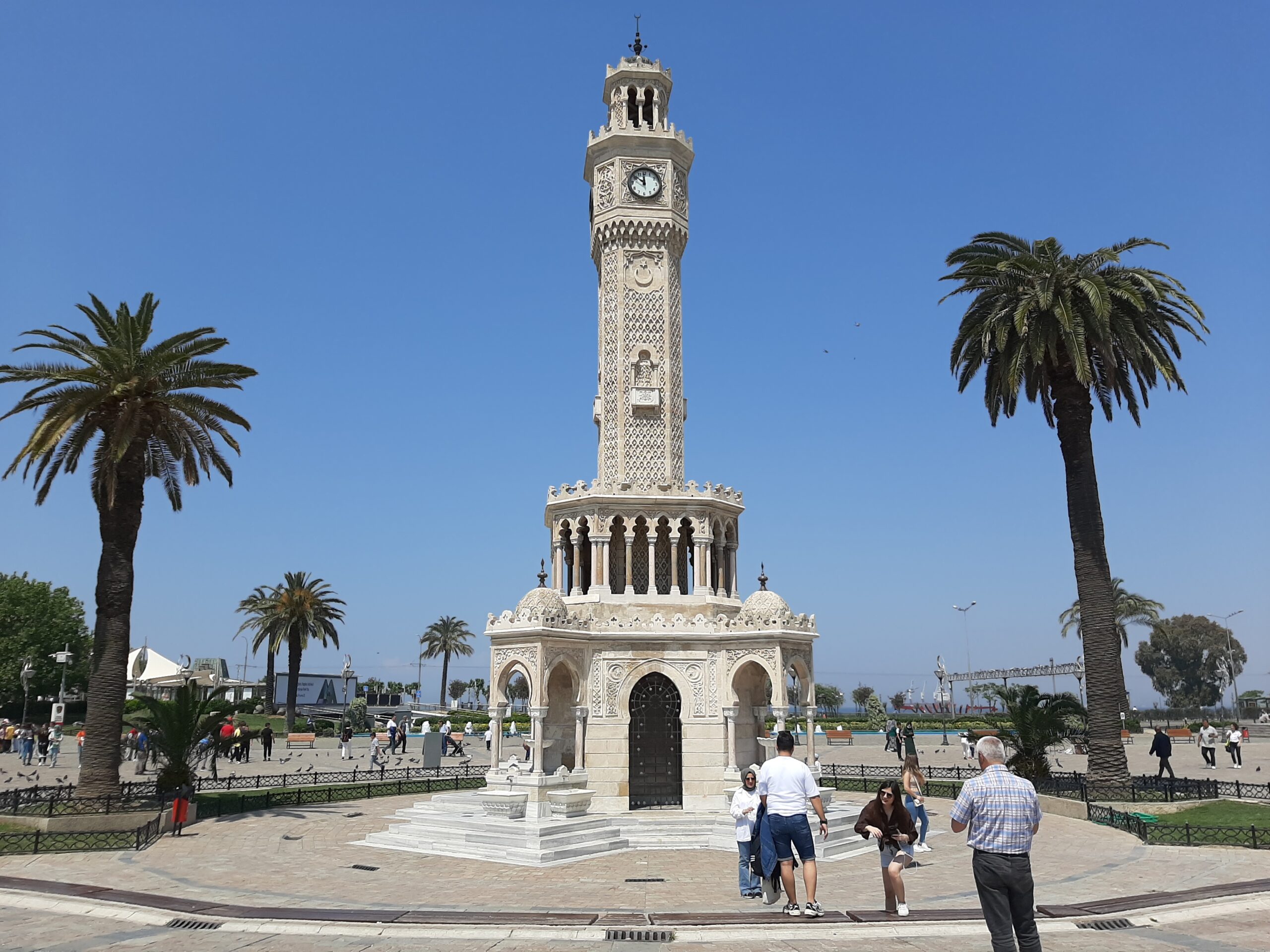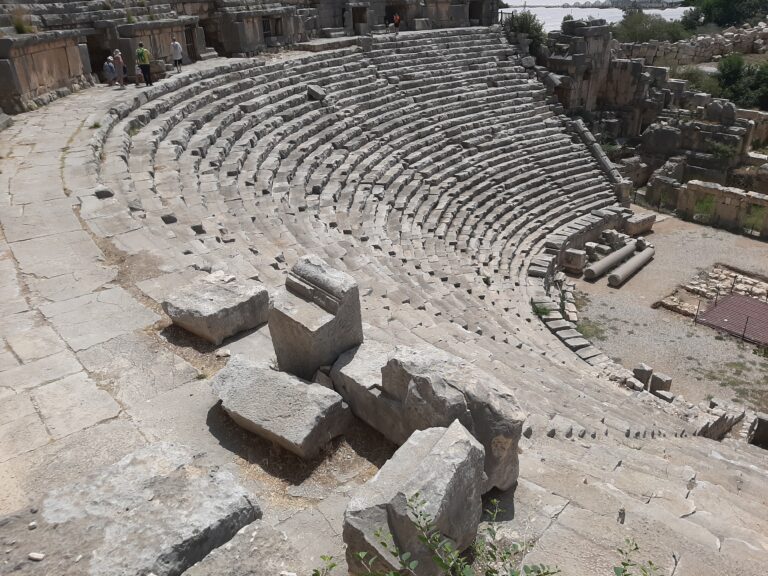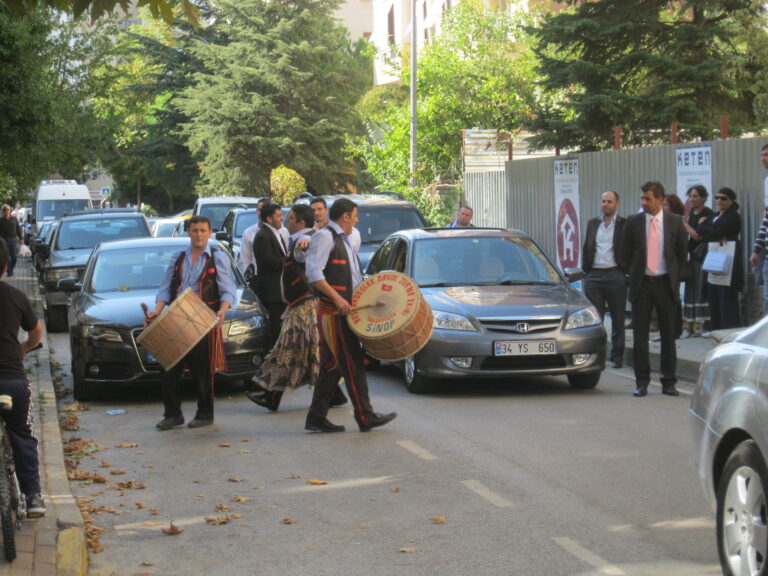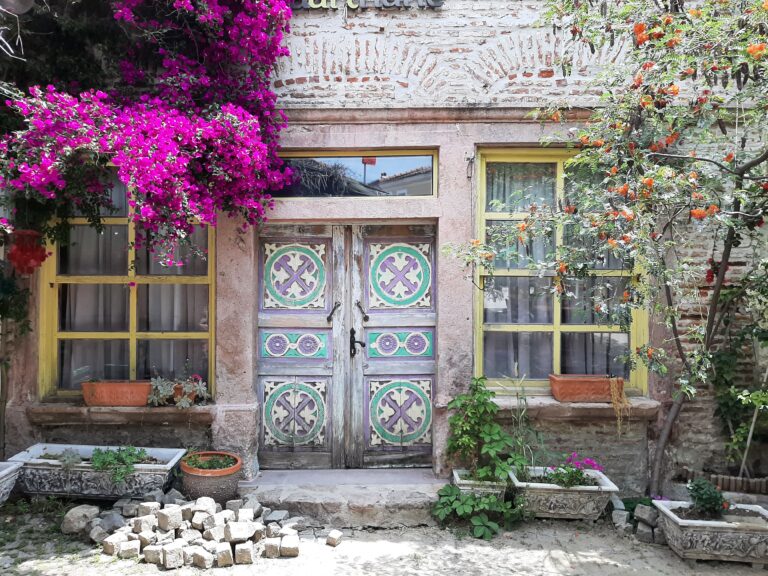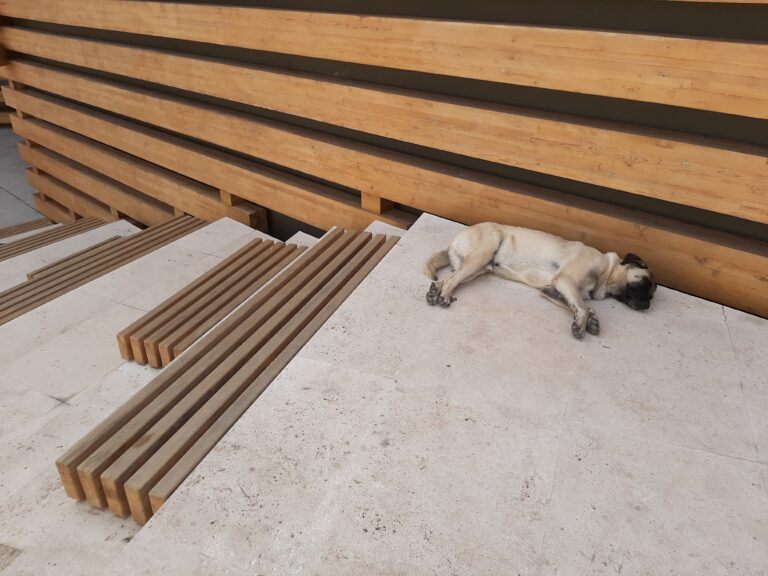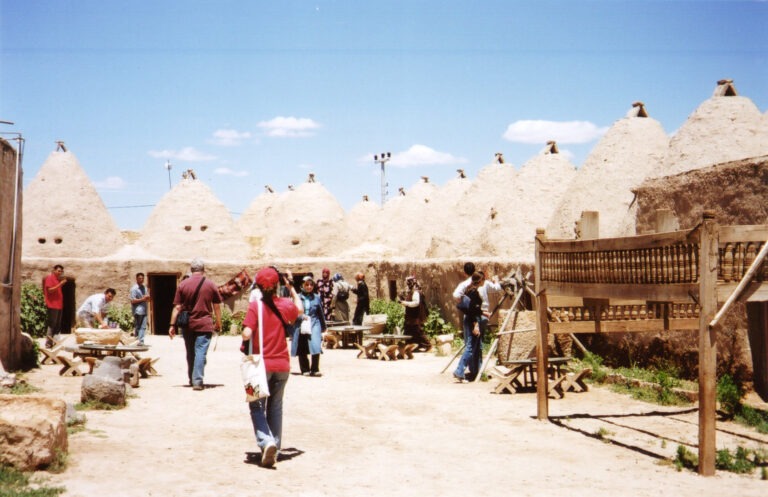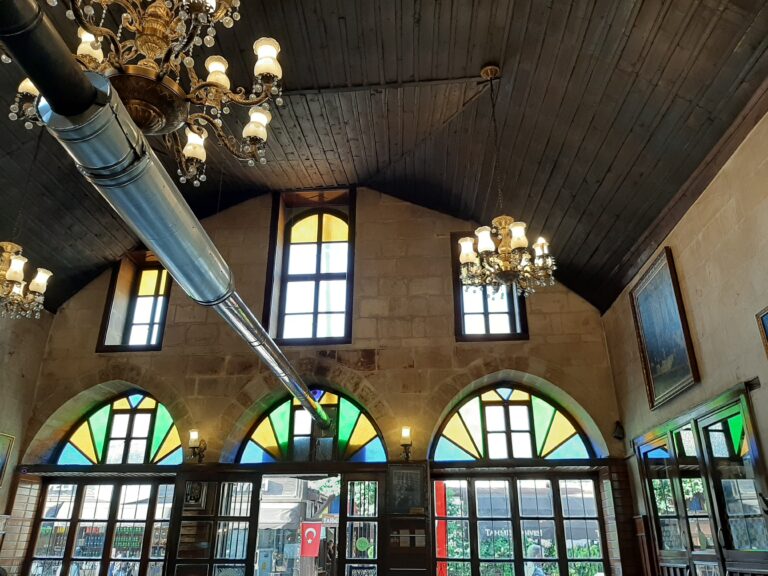Izmir – What to see and do
IZMIR HISTORY
Izmir, Turkey’s third most populated city, stretches around the Gulf of Izmir on the Aegean Sea. It’s where the first ever railway line was built in the country to transport produce grown on farms 120 kilometres inland for export to Europe. The gorgeous Sarayı Borsa, the Palace Stock Market that once saw a vigorous trade in cotton, figs and a range of dried fruits including Sultaninas (dried raisins) brought to Izmir by camel, is still standing.
Like many cities in Turkey, Izmir has a long and varied history. It started off as a village called Bayraklı and was the preferred hunting ground of Alexander the Great. He favoured the slopes of Mount Pagos, now called Kadifekale Dağı. One day, after a hard day chasing game, he decided to take a nap and two nemesis came to him in his dreams. They instructed Alexander to build a city on the spot where he lay but first, in keeping with the times, he consulted the oracle Apollo over in Delphi. Apollo assured him the decision was a sound one, saying anyone who settled on the foothills of the mountain near the Sacred Meles Stream would be four times happier than they were before. Clearly Alexander took note because a new city was built on top of Mount Pagos in the 4th century BC.
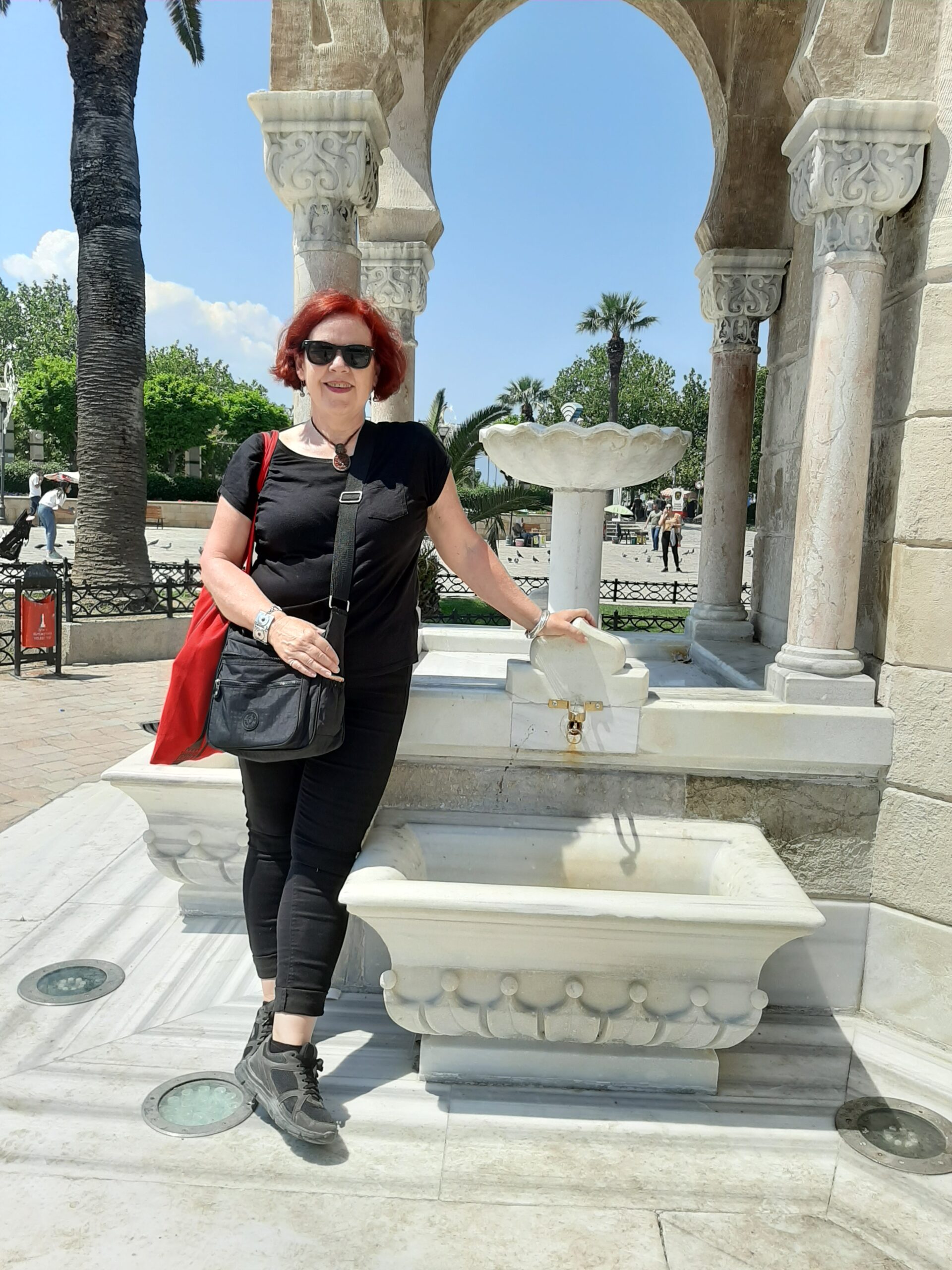
Until the early 20th century, Smyrna, as Izmir was known until around 1930, was home to a large mixed population. Turkish-born Greeks called Rum, Turks, Jews, Armenians and people of all nationalities such as Americans, Swiss, French and Italian, just to name a few, did deals, socialised together, worked in each other’s businesses or supplied goods and services to the rich. Money changed hands regularly and the wealthy enjoyed the high life. Aristotle Onassis was born in Smyrna and it’s where the English family the Whittall’s grew their business empire. Along with many of the city’s other elite, the latter lived in Bornova, a multicultural and affluent neighbourhood. Now called Bournabat, it was once a green leafy hamlet a train ride away from the city. Today it’s just one of many Izmir neighbourhoods sprawling inland, east of the waterfront.
The party ended in 1922 when a massive fire all but razed dozens of residences along the waterfront. At the time the city was dealing with an influx of Greeks fleeing from inland Anatolia during the Turkish of War Independence, and a massive build-up of international army divisions and navy boats in the harbour. The fire began on 13 September and lasted until it was eventually extinguished nine days later. It hit the Greek and Armenian neighbourhoods the worst, resulting in a large number of deaths. Many of the homes not totally destroyed by the fire fell into ruins through neglect, after the population exchange in the following years meant they remained empty. Please note how the fires started and who lit the first flame is beyond the scope of this post and my expertise. If you want to know more I suggest you start by reading about the history of the Greco-Turkish War in 1897 and go from there.
IZMIR NEIGHBOURHOODS TO VISIT
Kordon Promenade and surrounds
This 2.4 kilometre long flat walkway along the waterfront in Izmir is a popular spot for both fitness fans and those whose only form of exercise is a gentle stroll on the way to drink tea. The Kordon stretches from Konak Pier and Konak Meydanı in the south to Cumhuriyet Square and Alsancak in the north. Interestingly, the design for the black-and-white wave-patterned mosaics resembling ocean waves are the result of a trip to Brazil in 1958 by a former Turkish beauty queen married to then Izmir Mayor Faruk Tunca. His wife, Günseli Başar, admired the pavements at Copacabana Beach in Rio de Janeiro so much that Tunca decided to incorporate them into the Kordon the following year.
Today cyclists, joggers and walkers all enjoy using this waterfront pathway but if you’re not particularly sporty, fear not. There are plenty of restaurants along the way if you’re in need of sustenance. History buffs note, there is an Ataturk Museum to visit as well.
Konak Iskelesi (Konak Pier)
The popular upmarket Konak Pier AVM (shopping centre) which includes a cinema and restaurant with lovely views of the bay, is described on most websites as the work of Gustave Eiffel. While it’s highly possible the pier, originally designed as a customs building in 1890, was the work of Eiffel’s architecture and construction firm, local historians say it’s unlikely the design came directly from his hand.
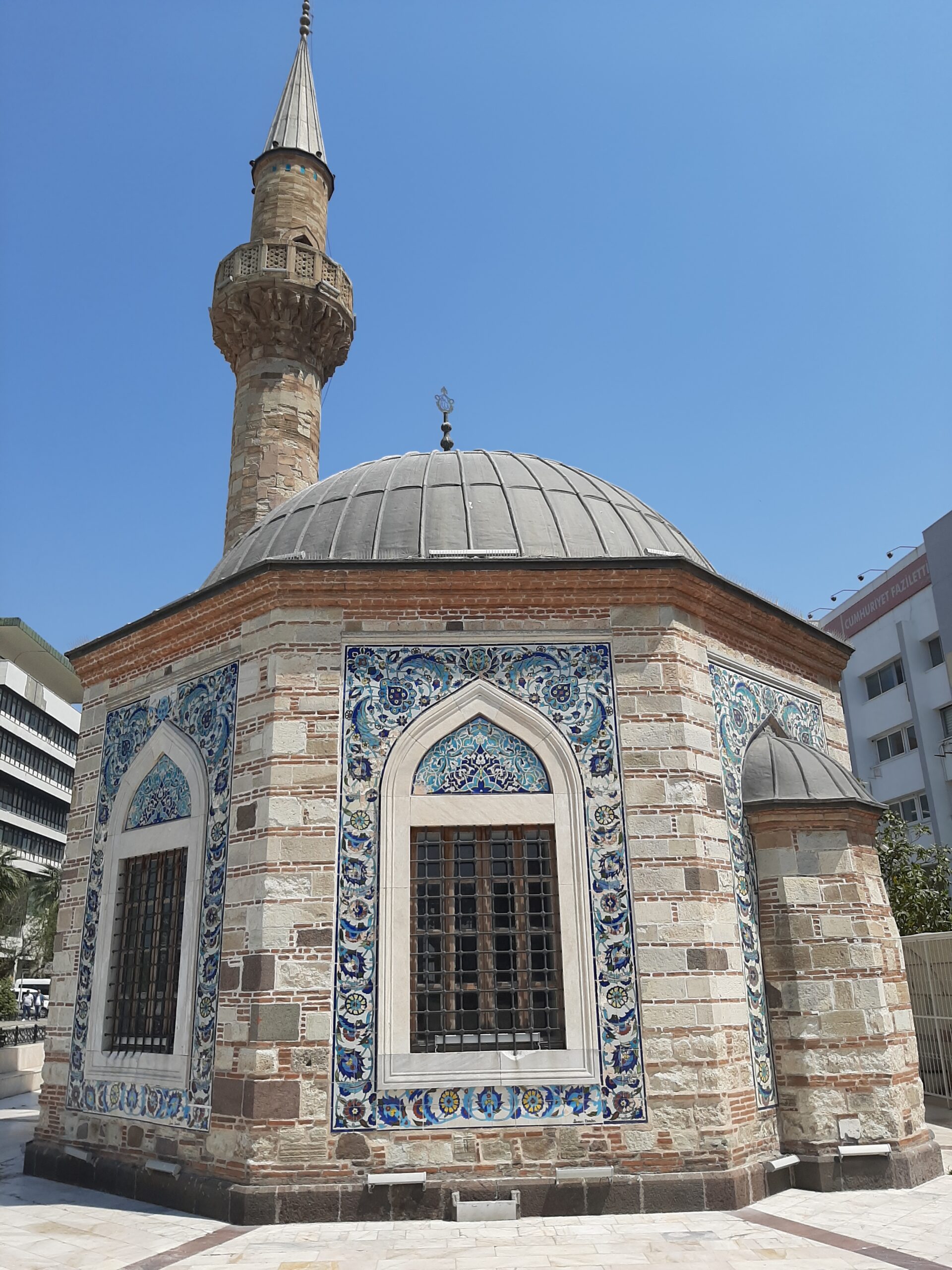
Konak Meydanı (Konak Square)
This square, named for the pier, is a popular spot with Instagrammers drawn to the Saat Kulesi, a clock tower gifted to the city by Ottoman Sultan Abdul Hamid II in 1901. Created by French architect Raymond Charles Péré, it’s a curious blend of North African and Andalusian designs, looking neither Turkish nor French. Péré was heavily influenced by Moorish architecture so each level of this 25 metre high structure is a flurry of columns, embellished capitals and horseshoe shaped arches. It’s easy to see why it makes the perfect backdrop for practising Instagram poses, but before you raise your phone take a moment to well, just take it all in. It’s quite fabulous.
Just behind it, somewhat overshadowed by the blinding white of the clock tower on one side and a stately government building on the other, is the small Konak Camii. This mosque, built in 1748, is covered in brilliant colourful Kutahya tiles.
Tarihi Asansor (Historical Elevator)
Şehit Nihatbey Caddesi No 76/A, open 7 days a week: 8.00-24.00
Despite the fire, Izmir still has a number of architectural sites reflecting the history of former residents of the city. The Historical Elevator, around one and a half kilometres from Konak Square, is one of them. It was built on a street called Asansör Sokak (Turkish for elevator) by a Jewish trader in 1907, to make moving from the Karatas to the Halil Rifat Pasa neighbourhoods of town easier. If you’re a fan of elevators and funiculars as I am, you’ll enjoy it solely for the ride. In truth though I wish it was still occupied by the casino, cinema or photo gallery, I don’t care which one, as in World War II. There’s a café now but that’s not nearly as glamorous.
The view up the top is only spectacular if you’re a fan of modern cityscapes which I’m not. For me it’s all about the ride to the top. Instead stroll along Dario Moreno Sokak, as Elevator Street is now called, lined with colourful buildings converted into cafes and restaurants, and walls painted with street art. Dario Moreno was born David Arugete in 1921. His large Jewish family were poor so while he studied to become a legal clerk he also worked at night, playing guitar and singing. He built up a following performing at Bah Mitzvahs and other Jewish festivities, performing under the name Dario Moreno. He’s best known for his version of the multilingual song Ya Mustafa, first made famous in the 1950s when featured in a number of Egyptian films.
Kültürpark İzmir (Izmir International Fairground)
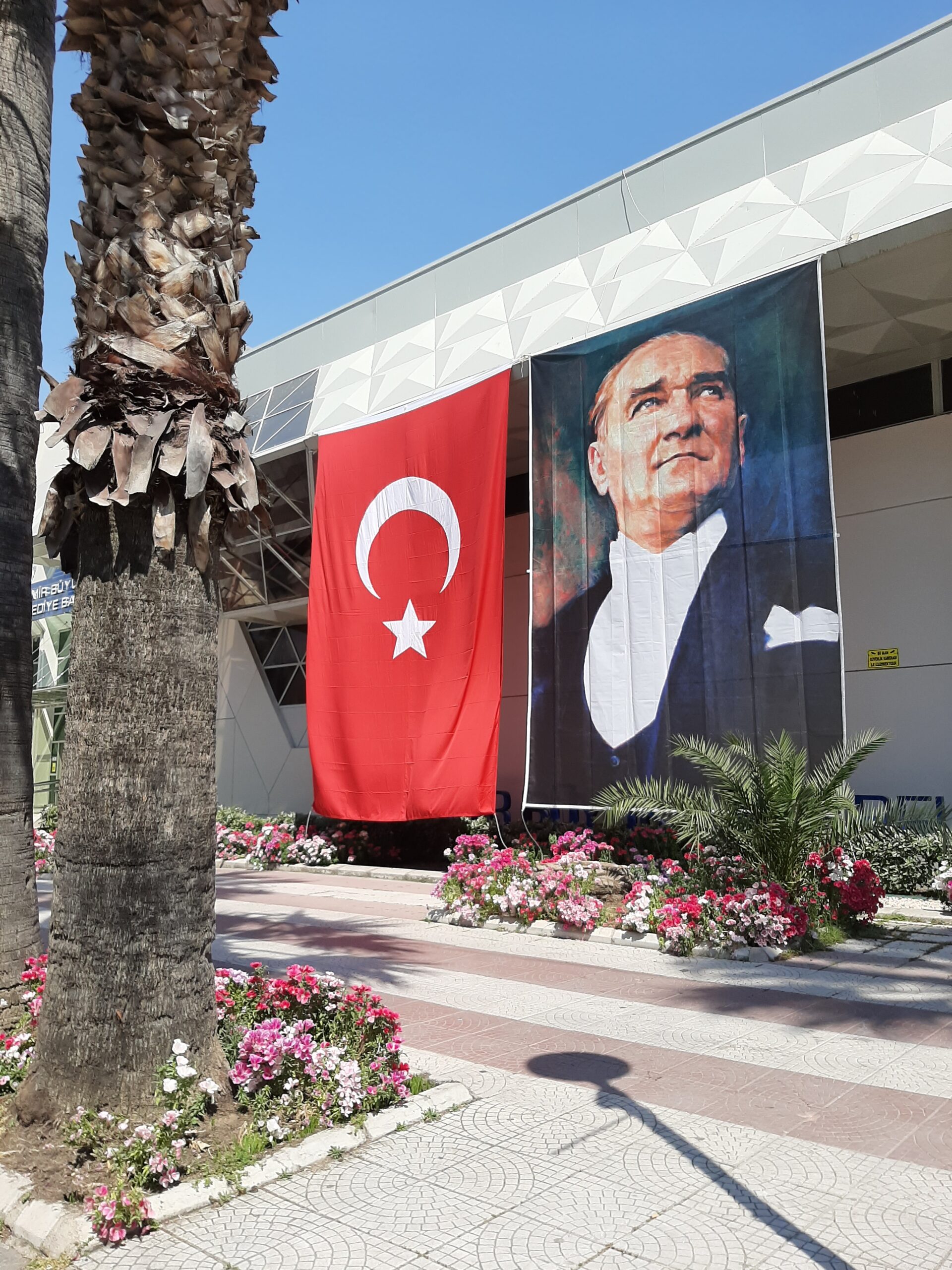
Izmir Kulturpark provides a welcoming green oasis in the midst of Izmir’s forest of white high rise apartment blocks. There are many pleasant paths to stroll or you can rent bicycles to explore more of the grounds. The park was founded in 1936 and opened on January 1 as an international fair ground with 14 indoor exhibition halls, four conference halls, an art centre and a separate painting and sculpture museum, a sports hall and much more. Today the park is home to the council headquarters. There are more than 8000 mature trees and around 200 plants, an open air theatre, a dog training centre, athletics track, tennis courts, swimming pool and artificial grass football pitches. Prior to the great fire the area was home to a mainly Armenian population, built around St Stephanos Church.
MUSEUMS & ARCHAEOLOGICAL SITES IN IZMIR
Namazgah Mah, Tarık Sarı Sokak No 29, open 7 days a week: 8.30-17.00
Entry fee: €6*
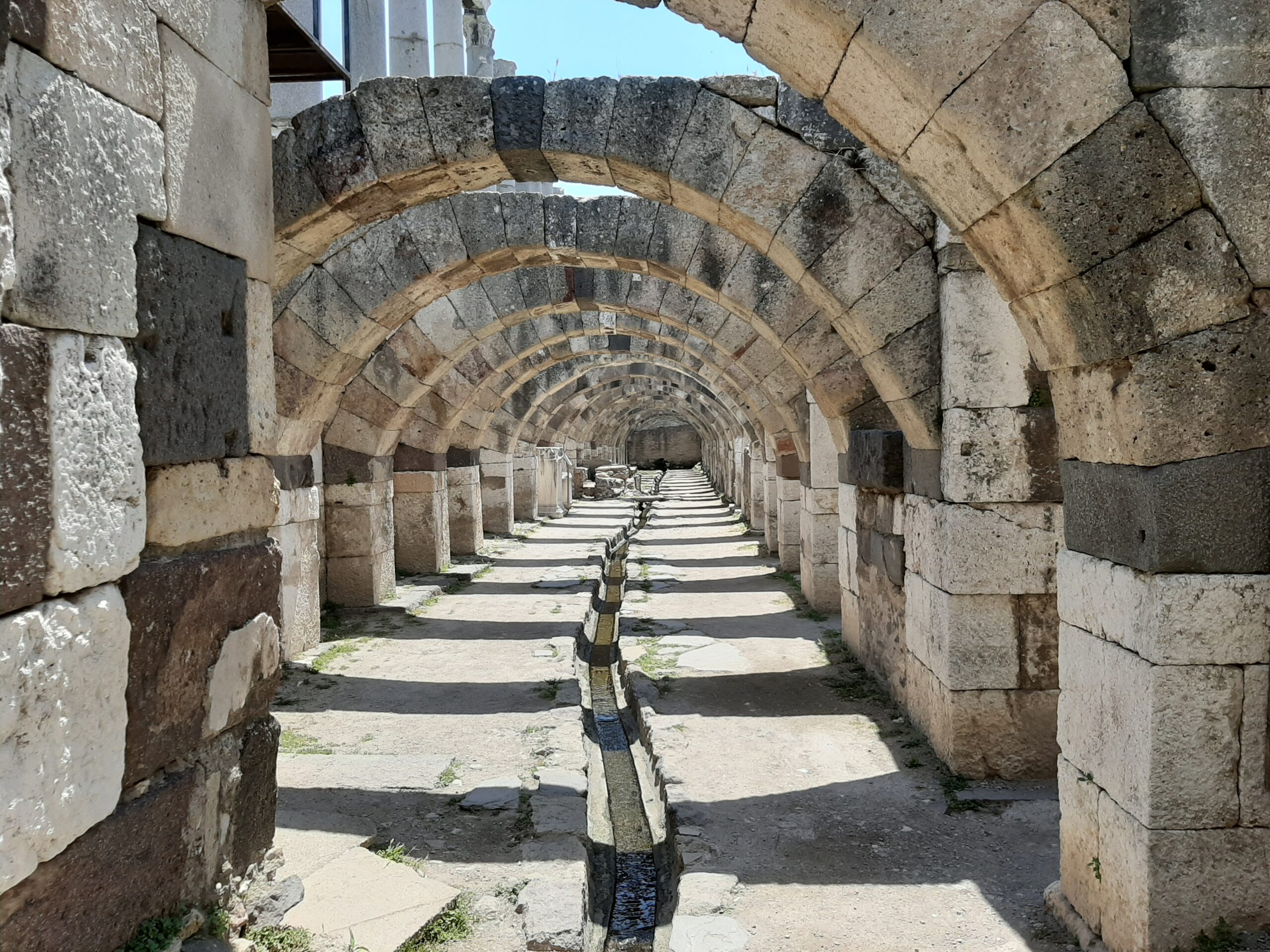
Izmir was an important stop on the Silk Road and the agora was where everything happened. The original agora was destroyed back in 178AD but Marcus Aurelius had it rebuilt, resulting in a 4-storeyed structure with a basement and civil Basilica, similar to a public hall.
Now the ruins of this Roman-Greek marketplace built for Alexander the Great are surrounded by hillside residential neighbourhoods, bustling market streets, and tall commercial buildings. However you can still see engravings on the lower walls and columns, identified as an early form graffiti. Although many of the external walls and roofing are missing, the infrastructure is intact, so it’s educational and fun to walk along and past the corridors, colonnades and vaulted chambers, and up and down stairs to get a sense of the overall design and size. There are old tombstones propped up along one of the boundary walls, the remains of a Muslim cemetery built over the site at some point in time.
Izmir Kultur Sanat Fabrikasi (Izmir Culture and Arts Factory)
Mimar Sinan Mah, Ziya Gökalp Bulvarı No 36, open 7 days: 9.00-21.00
Entry fee: €10 (includes entry into Painting and Sculpture Museum)
On 29 April 2023 the Turkish Ministry of Culture and Tourism opened a Culture and Arts Centre in this former three storey tobacco factory, designed by a French architect. Now it houses a library, a Museum of Archaeology and Ethnography displaying over 6000 artefacts all discovered in the Izmir region and a tobacco museum.
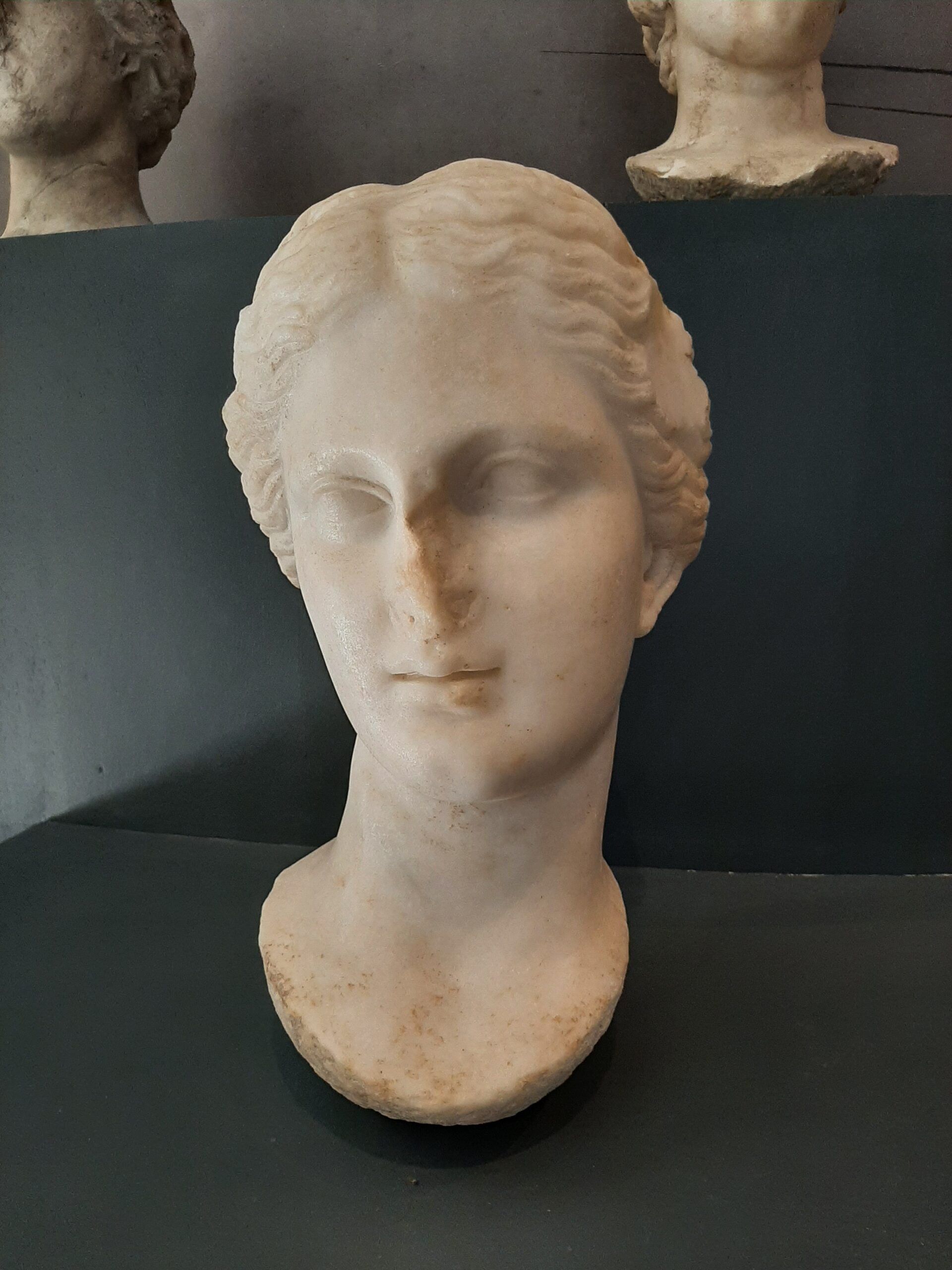
Each room of the museum is arranged thematically. The first floor has objects from the Archaic and Classical ages, the second is given over to the Hellenistic and Roman Periods while the third floor features ethnographic displays. There are huge sarcophagi, life sized statues and numerous busts. It was here I learned busts are not just busts. By that I mean if the bottom of neck on the bust is rounded, it means the head of an existing sculpture was replaced when a new god or goddess was worshipped, rather than making a whole new sculpture.
The ethnography displays give a great insight into daily life of the past with tableaux including hamam equipment, a complete chemist set up, copper and metalware making workshops, elaborate bridal headwear and jewellery, Yemeni and Derya shoes and Greek icons. For me though, the small room under the eaves dedicated to the history of the building was a standout. There’s a cigar rolling table and samples of tobacco leaves from different parts of Turkey displayed in frames around the walls, assorted pieces of machinery and the lovely smell of wood and dried tobacco. I loved it and I don’t even smoke!
İzmir Arkeoloji Müzesi (Izmir Archaeological and Ethnography Museum)
Halil Rıfat Paşa Caddesi No 4, open 7 days a week: Mon-Sun 8:30-17.30 in winter, until 19:00 in summer.
Entry fee €4
After reading the description of this museum and comparing it to the many dozens of archaeological museums I’ve already seen, I decided to give this one a miss. That doesn’t mean you should too. Amongst the highlights are bronze statues recovered from ships wrecked in the Aegean Sea, and a garden full of stele, sarcophagi and random intriguing archaeological pieces.
IZMIR CHURCHES AND SYNAGOGUES
Necati Bey Bulvari No 2/A
Dedicated to St. Polycarp, this church is the oldest place of Christian worship in Izmir. It was built in 1625 in honour of the saint who was converted to Christianity by the Apostle John. St Polycarp became the first bishop of Izmir but was burned at the stake by the Romans. The building is barrel-shape in design, with a magnificent interior decorated with colourful murals restored by a French artist, infamous for inserting his own likeness into the religious scenes.
Izmir Synagogues
Bet Israel
Mihtat pasa Cad 265, Karataş
Bet Israel is the city’s largest synagogue. It was built in 1907 and still operates as a house of worship. It’s similar in design to Italian synagogues with woodwork carved by Italian master carpenters. Of particular note are the teva, the stand set in the middle of four columns supporting the ceiling that also divide the ceiling and the synagogue into 9 section and the ehal that contains Torah scrolls. Each of the arched windows are topped by a Star of David and there is a small exhibition room on the second floor.
Originally there were a total of 34 synagogues in Izmir, but now only about a dozen remain. If you want to visit the Bet Israel and other historical synagogues in Izmir you’ll need to apply for permission in advance. Ebruli Turizm can help you with this.
WHERE TO SHOP IN IZMIR
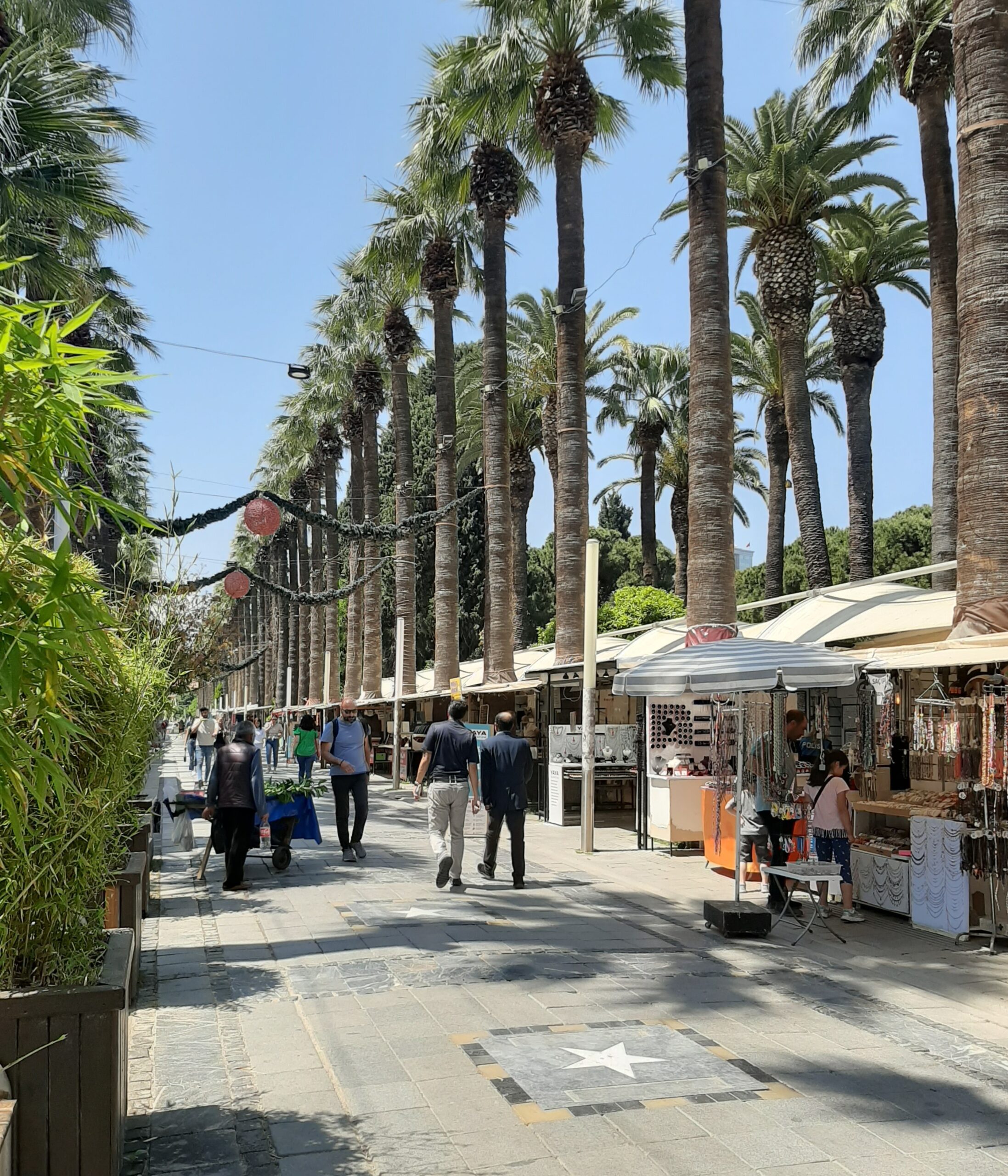
Kemaraltı Çarşsi (Kemaraltı Market)
Konak
This very basic and busy local bazaar located next to the 16th century Hisar Cami (Izmir’s largest mosque) is popular with domestic customers but has some nice han inside well worth a look. Kızlarağası Hanı (Daughter’s of the Aga) was built as aa caravanserai in 1744. Originally right on the water, this han was at the centre of Izmir’s trading business, with goods delivered here to be transported elsewhere by ship. It hit its peak in 1778 but by the last quarter of the 19th century developments in transportation and changes to the economy saw the han decrease in importance. At one point it was reduced to being a storage depot, but is once more a bustling centre of commerce.
The Bakır Bedesteni (copper bazaar) named for the copper workshops that once filled the tiny spaces is in the most well-preserved section of market area. In its heyday caravans would arrive and unload their goods on the ground floor and tether their animals, camels, mules, donkeys and horses, overnight. Upstairs, several rooms with furnaces accommodated the traveling salesmen. Later on it became the place to purchase silk from Iran.
Two other market inside Kemeralti are Cevahir Bedesten and Çuha Bedesten. There is also an extra floor called the Saçmahane, built in 1745 to accommodate an additional row of shops. An historic courtyard features tea and coffee houses, including Şükrü Bey’in Yeri, where Turkish coffee is brewed on coals inside the cup instead of a pot.
This palm lined avenue is packed with second hand booksellers, jewellery and bijuterie stores.
WHAT TO EAT IN IZMIR
Despite managing to see a lot in Izmir I didn’t eat there that much on my two visits, as I was in Ilica and Urla around mealtimes. However I do know you should head for restaurants in Kemeraltı if you’re after fish and mussels, priced by the kilo.
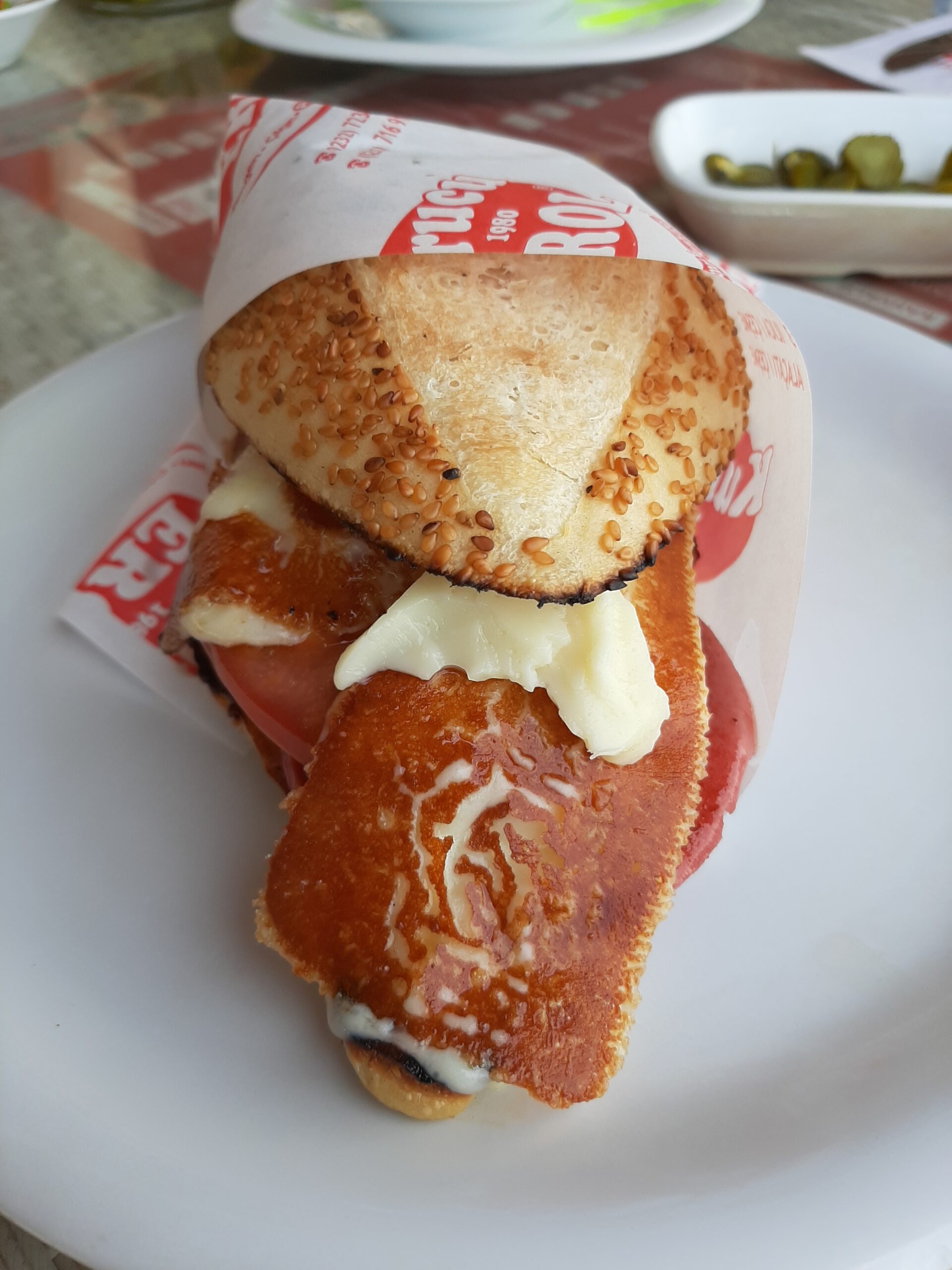
Two snacks typical of the area are boyoz and kumru. Boyoz are round flaky savoury pastries of Sephardic Jewish origin, often eaten with a hard-boiled egg. I’m not a big fan of eggs done that way, but the tasty slightly greasy texture of the boyoz was wonderful. Kumru fit the bill if you’re after something more hearty. A long sesame seed roll is crisped on the grill then filled with a slab of cheese, grilled to gooey perfection, a thick slice of sucuk and some salami, finished with tomato. Most places have jars of turşu (pickles in English) if you want to spice things up even more. Simple but satisfying.
No one’s exactly sure who invented the Çörçil, a cool refreshing drink made from Turkish soda, lemon juice and salt Churchill drink, but it’s definitely an Izmir invention. It first appeared in the Karsiyakaya area of the city, and some say it was named for Churchill, either Winston or Ahmet. Confused? This article goes into more details. However it came about it’s perfect on a hot day.
WHERE TO STAY IN IZMIR
On my most recent trip to Izmir I stayed at the Hyatt Regency Izmir İstinyePark. I was a guest of the hotel on a press trip with TGA Turkey Tourism but everything else I saw and did in Izmir I paid for myself.
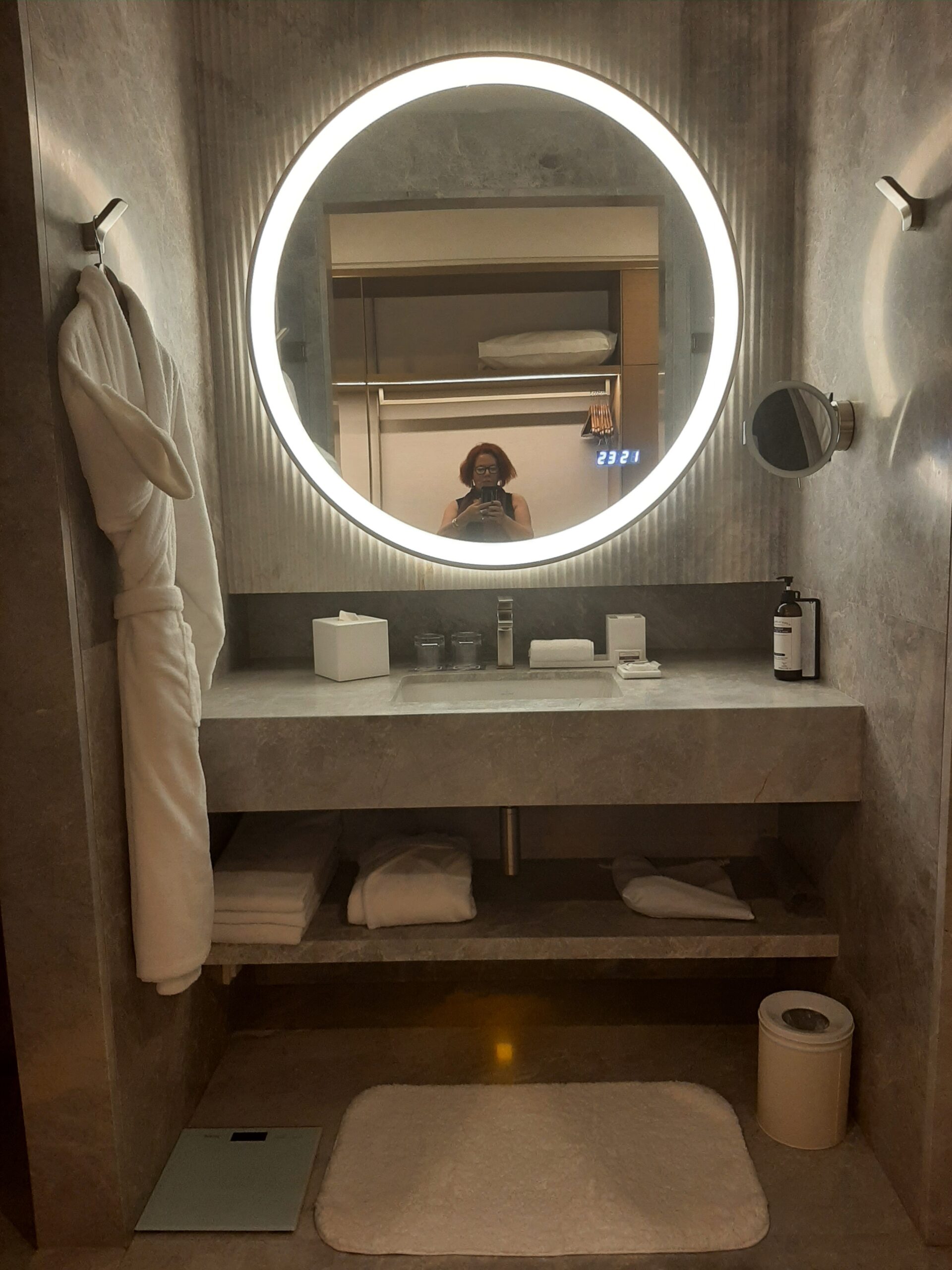
The Hyatt Regency Izmir Istinye Park Hotel opened in December 2022. It has 160 rooms, all with a sea view. There’s a penthouse at the top, meeting rooms, rooftop swimming pool and even a ball room. Post pandemic the hotel group realised that more than ever nature is valuable and needs to be sustained for future generations. With this in mind they engineered the building to run on solar power, the rooms are equipped using the most up-to-date sustainable methods such as refillable soap and shampoo dispensers and water bottles, information provided via QR codes or on wooden panels instead of paper, locally sourced food on the breakfast buffet and in the dining room. They have also engaged in an art project in conjunction with Istanbul Modern, showcasing original works in the rooms and common areas.
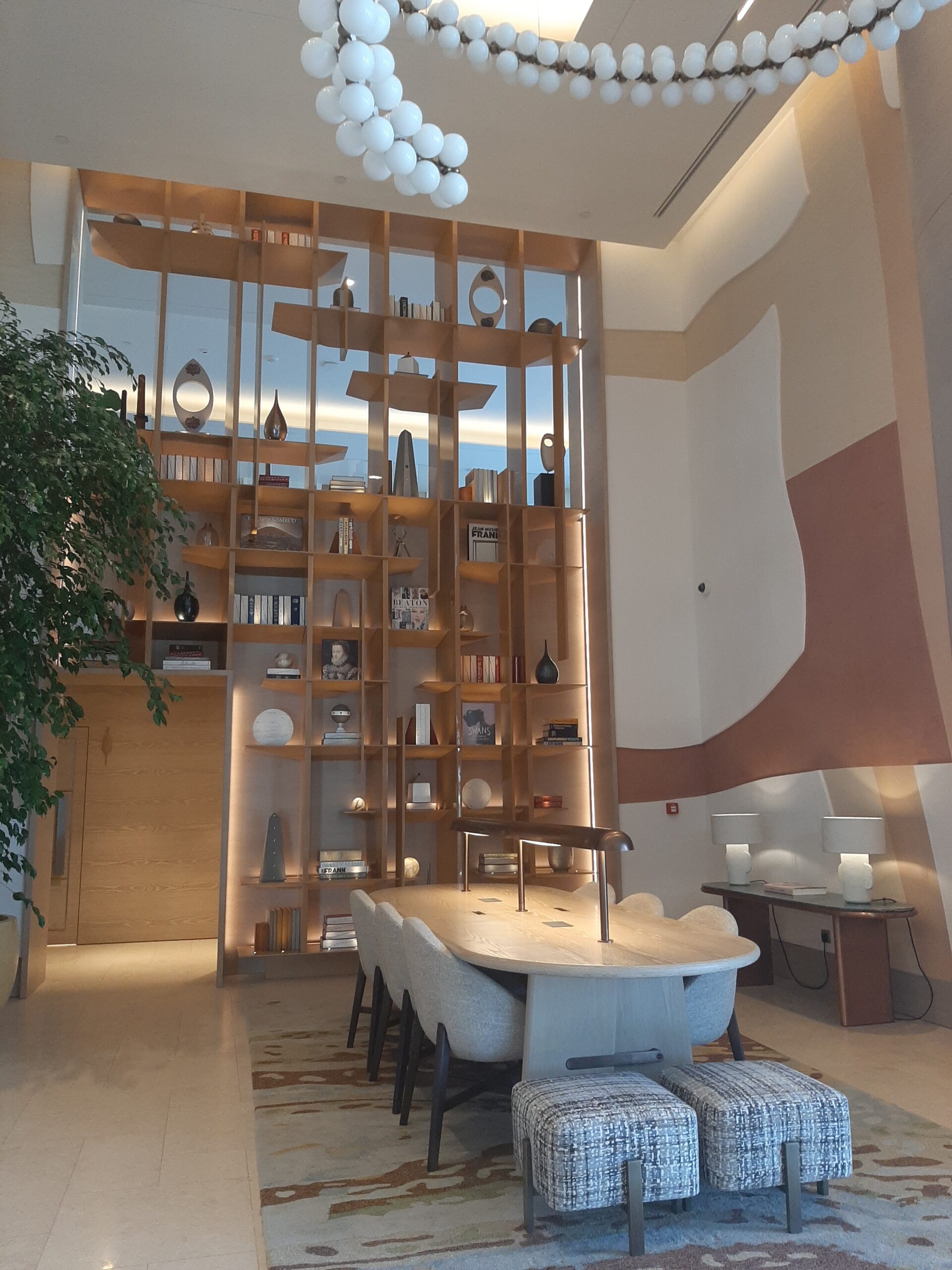
Those in search of retail therapy will appreciate the shopping centre next door otherwise it’s just a 5 min walk to the T2 tram stop for the 20 minute ride to Konak Meydanı.
Most of the time it’s down to me to find my own accommodation and I use Booking.com.
WHEN TO GO TO IZMIR
Izmir’s climate is mild year round and although it gets very hot in summer, it’s a dry heat that I find much more bearable than the humidity of Istanbul. That said, if you like walking as I do, you’ll enjoy wandering the city more in spring and autumn.
GETTING TO, FROM AND AROUND IZMIR (and surrounds)
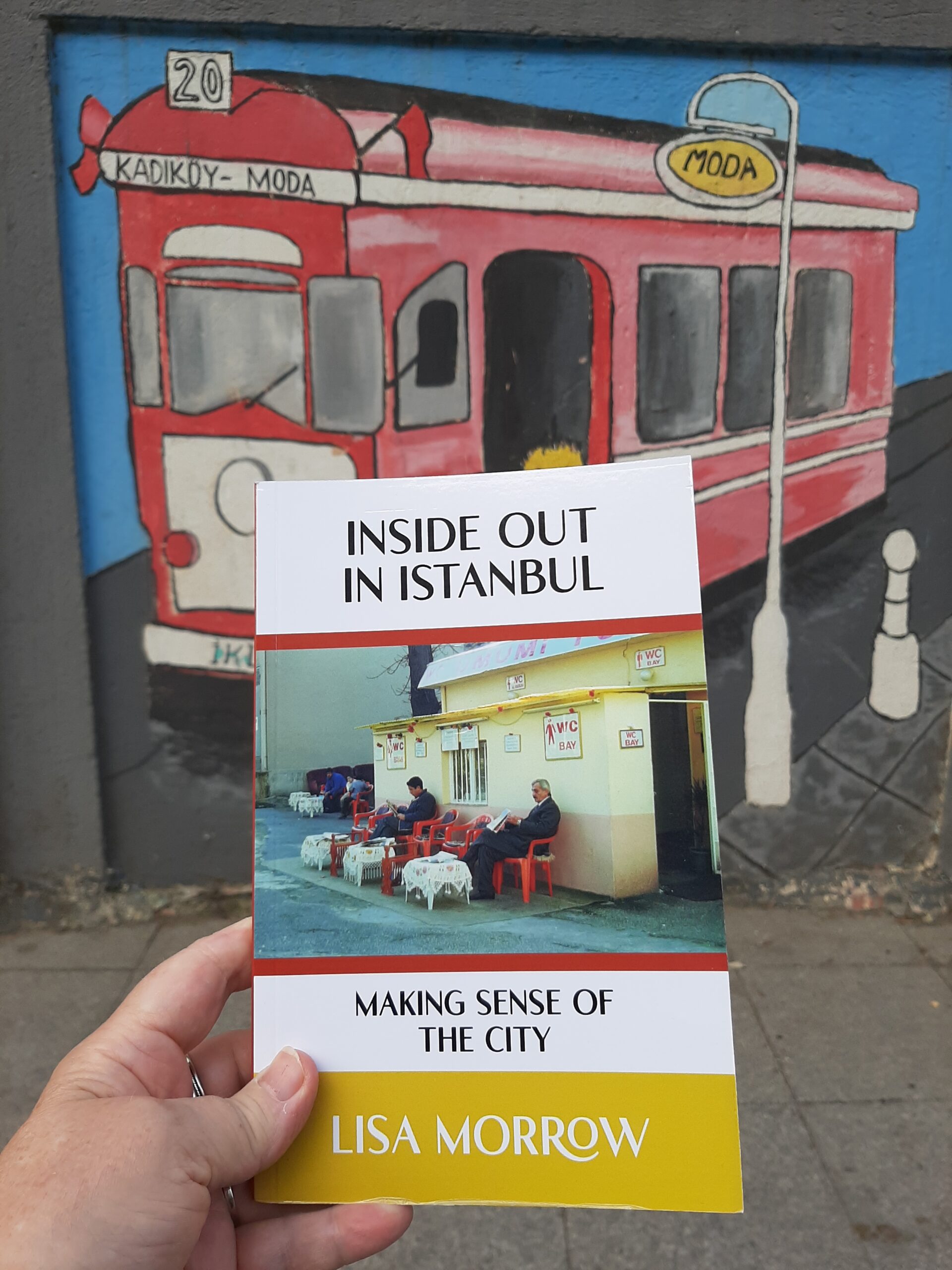
There are some flights from European cities direct to Izmir, but most people fly into Istanbul first. I recommend you spend at least a couple of days in the country’s cultural capital. Let me guide you around Kadikoy, on the Asian side of the city, with my audio walking tour Stepping back through Chalcedon or venture further afield with my bespoke guidebook Istanbul 50 Unsung Places. I know you’ll love visiting the lesser-known sites I’ve included. It’s based on using public transport as much as possible so you won’t be adding too much to your carbon footprint. Back home, read about what you’ve seen and experienced firsthand, in my three essay collections and memoir about moving to Istanbul permanently.
You can find even more ways to experience Istanbul and Turkey with food tours, visits to the old city, evening Bosphorus cruises and more using the GetYourGuide website and Viator.
From Istanbul you can catch a plane from either Istanbul Airport or Sabiha Gokcen Airport to Izmir. When I book my flights I like to use Kiwi.com.
Depending on your luggage and budget, from the airport you can catch a taxi to Izmir city centre, hop on the Havas Shuttle bus, or use the IZBAN, Izmir’s suburban train service. You can take it from the airport direct to Alsancak Gar, the main station in Izmir. Alternatively hop off one stop earlier at Hilal and change to the metro line for Basmane, Cankaya and Konak stops located closer to the main sights. You’ll need to buy an IZBAN card and load it with credit or you can also use a contactless Visa or Mastercard to get you through the turnstiles. All up the journey takes about 30 minutes.
However I prefer to travel to Izmir by intercity bus. Once you factor in getting to the airport in Istanbul in advance of your flight, the time spent waiting for your luggage and then the trip into town, sitting in an air conditioned bus watching a movie on my laptop or catching up on work is far more productive. From the Asian side the trip takes 6 to 7 hours (depending on when you leave), and you get to see some of the countryside as well. Don’t to forget to factor in another 45 minutes on a local bus into the town centre.
DAY TRIPS FROM IZMIR
A day trip to Birgi should be high on your itinerary. I’ll be adding more information on day trips to Ephesus, Urla, Alacati, Cesme and Sardis in coming months. If you’re looking for a smaller seaside town, Ayvalik is only a few hours up the coast.
*****************************************
Here are some other tips to help you plan your trip to Izmir and Turkey in general.
Don’t pay extra for an E-VISA. Here’s my post on everything to know before you take off.
E-SIM are the way to go to stay connected with a local phone number and mobile data on the go. Airalo is easy to use and affordable.
Even if I never claim on it, I always take out TRAVEL INSURANCE. I recommend Visitors Coverage.
If you’re travelling alone, check out this post on useful solo travel tips Turkey for women (and men)
However you travel, stay safe and have fun! Iyi yolculuklar.
************************************************
*there’s a new pricing system as of 1.3.24. Entrance fees are quoted in Euro but paid in TL, calculated on daily exchange rate. Some of these sites are free for Turkish citizens holding a Muze Kart.
